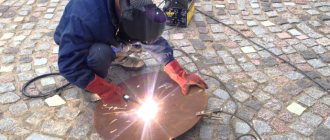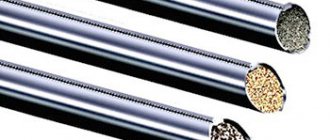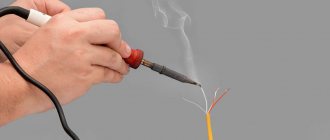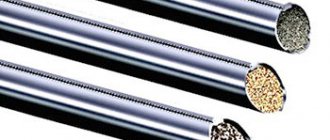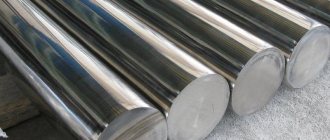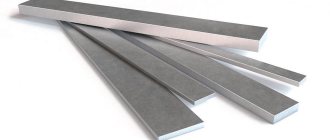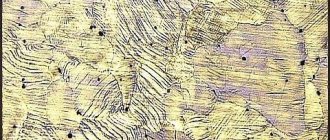Many types of fusion welding use a special wire called a welding wire. It is used in the manufacture of electrodes in the most common types of welding - manual arc, gas and using semi-automatic and automatic machines of all types.
It is a product of a certain length, made of metal, having a small cross-section in relation to the length. To make the right choice of welding wire brand, you need to know the basic criteria for its selection. The strength and quality of the connection obtained by different types of welding depends on this.
Types of welding wire
When carrying out welding work with different types of metal, it is necessary to select the right consumables.
In turn, they are divided into the following types:
- Powder. It is recommended to select it for carbon steel types, the surface of which will be subject to heat treatment;
- Aluminum. The choice of such a product should be made for steel that contains silicon, manganese or magnesium;
- Stainless steel. It was developed for the production of stainless steel workpieces. Such materials contain chromium and nickel alloys;
- Copper plated. This model of welding wire is suitable for high-alloy types of steel;
- Steel. It is used to work with low-alloy or medium-alloy types of steel base.
Now let’s take a closer look at each type of product, its characteristic features and purposes during use.
Chemical composition
Based on the chemical composition, there are 6 grades of low-carbon steel wire, 30 grades of alloy steel wire, and 41 grades of high-alloy steel wire. Alloying elements can be nitrogen (N), tungsten (W), nickel (Ni), silicon (Si), aluminum (Al), zirconium (Zr), chromium (Cr), vanadium (V), titanium (Ti) , molybdenum (Mo), copper (Cu) and niobium (Nb). The following form of marking of welding wire is accepted:
Welding wire marking form
It contains all the necessary information about the composition and purpose of the product.
Wire for stainless steel
The main purpose of this model is to connect a metal base, which contains chromium and nickel alloys.
Its advantages are considered:
- High-quality seam;
- Absence of any damage;
- Possesses corrosion resistance;
- Does not spatter metal when heated;
- Provides a stable combustion arc during operation of the welding machine.
Stainless steel welding wire has a long service life. For its manufacture, high-alloy steel with a large amount of chromium and nickel alloys is used. These materials increase the corrosive properties.
In turn, stainless steel wire for welding is divided into two types:
- Solid. It is used for welding seams for shielding gases. It blocks the penetration of oxygen into the area of thermal contact of the elements. If air or other types of gases enter the seam, an oxidation reaction will occur, the products of which can damage the weld;
- Powder. It consists of thin tubes. Inside the product there is flux and special elements that form gases when heated. This composition makes it possible not to use an additional protective mixture during welding.
Reasons for popularity
When using these electrodes, experts note the ease of ignition of the primary arc. A repeated arc also occurs without unnecessary difficulties. Working with them, you can easily weld tacks, as well as create root and short welds .
Many specialists also choose products from this brand because they provide comfort when performing work, especially when it becomes necessary to weld wide gaps. This task often arises when performing work on the installation of metal structures. During welding work with these electrodes, slag appears. However, it can be removed from the seam surface without any difficulty.
Copper-clad wire
This type of consumable element has the same advantages as the stainless steel type. Welding wire with a copper surface allows you to reduce the consumption of tips for various devices.
It was manufactured to properly join carbon-based and high-alloy types of steel. Work with such material is carried out in a gas protective environment.
Copper-clad wire is sold in the form of plastic cassettes on which certain lengths of the product are wound. The thickness of the material can vary from 0.6 to 1 mm. It promotes rapid ignition of the welding arc. Thanks to it, it is possible to maintain combustion in different welding modes.
Activated
Inside the activated welding wire there is a small amount of powders, which are pressed in the center and look like wicks. This type of filler material is used to work in pure carbon dioxide or its mixture with other gaseous substances.
The activation function is performed by carbonates of alkali metals and barium; oxides of titanium, silicon, magnesium; calcium fluoride. As a result, the welding arc burns stably, and a high-quality seam is formed without metal spattering.
Characteristics of steel wire
This type of product can be used in any field. Most often it is chosen for construction and industrial work. It can be classified according to several criteria.
The main ones are strength, cross-section, diameter and alloy used for production.
Today, a large number of varieties of such material are known. In turn, they are divided into:
- Welding;
- Spring;
- Reinforced;
- Ropeway;
- Prickly.
The diameter depends on the type of consumable. Popular brands are divided into several types:
- For working with low carbon steels;
- For fixing medium and low alloy alloys;
- For welding high-alloy substrates.
Most steel consumables can be copper plated. As a result, it helps protect the weld surface from further oxidation and also improves the quality of work.
Main varieties
The main characteristics by which products are divided are:
Cross-sectional size and shape; Type of final processing; Surface type; Chemical composition of steel; Application area. Products are divided into groups based on thickness. Products of the first group are the thinnest, their thickness is less than 0.1 mm. The ninth group includes products whose cross-sectional size is more than 8 mm. Products according to GOST are manufactured in round, square, multi-faceted and shaped profiles.
The final treatment provides the required mechanical properties. To strengthen the mechanical strength and durability, the products are thermally treated: hardened, annealed and stabilized.
Based on the type of surface, products are divided into coated, unfinished and finished. Zinc, copper, aluminum and brass are used as steel coatings. For finishing, the surface is ground, polished or etched.
Types by purpose and area of application:
General purpose; For the production of meshes; For reinforcing reinforced concrete structures; Ropeway; Welding; String; Spring; Structural; For air communications; For wires and cables; Linking; Printing; Needle room.
Depending on the purpose and required performance characteristics, products are made from steel of various types and grades. General purpose products, as well as binding products and those used for reinforcing reinforced concrete products, are made from low-carbon steel. For the production of springs, wire cores, spokes and ropes, carbon, alloy and high-alloy steels are used. For some structural types, special requirements are put forward for steel in terms of the content of carbon, chromium, nickel and other chemical elements.
Description of aluminum wire
It is used for semi-automatic welding. Thanks to it, it is possible to create a structure from aluminum alloys and metal components based on silicon and copper. Aluminum welding wire has a number of advantages, including the following:
- High strength;
- Same color. The shade of the metal seam accurately matches the shade of the iron base that makes up the structure;
- Corrosion resistance.
The products are used in industrial and shipbuilding enterprises. Thanks to aluminum welding wire, it is possible to create a high-quality model. Aluminum alloy has ductility. It is often used for gas welding.
Experts say that any industry does not use parts containing 100% aluminum alloy. They still add different types of additives to it.
Attention! Experts say that in order for aluminum parts to be well connected to each other, the composition of the wire must accurately replicate the components present in the product. The exception is metal alloys with magnesium. It evaporates quickly during the welding process.
Where is flux cored welding wire used?
This type is used for connecting metal products. They contain low-alloy, medium-carbon and carbon steel. Another component in the installation process is the absence of a gaseous medium.
Another name for flux-cored wire for welding is fleece. It is based on the fact that not the entire body is made of a metal alloy. The inner container is filled with a special powder.
The main advantage of this material is considered to be high-quality seams. During operation, a powerful arc is formed, which allows you to fix iron workpieces.
Such wire is divided into five categories:
- Organic;
- Rutile fluorite;
- Fluorite – carbonate;
- Rutile;
- Fluorite.
Novice welders can sometimes confuse this model of consumable with steel welding wire.
When choosing consumables, it is necessary to take into account the diameter of the welding wire and the thickness of the iron structure.

